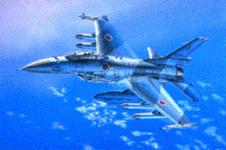
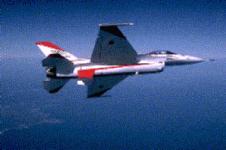
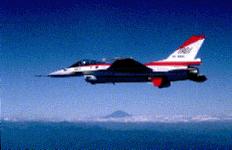
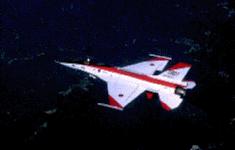
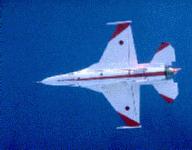




In October 1985, the Defense Agency began considering three development options for the FSX: domestic development, adoption of an existing domestic model, or adoption of a foreign model. The agency originally favored domestic development. The Japan Defense Agency's research and development arm, the Technical Research and Development Institute, announced that, except for the engine, Japan possessed the domestic capability to develop an advanced fighter for about $1 billion. But by late 1986, after consultation and much pressure from the United States, it decided to consider a coproduction agreement with the United States. And in October 1987, Japanese and United States defense officials meeting in Washington decided on a joint project to remodel either the F-15 or the F-16.
In November 1988, the United States and Japan agreed to cooperatively develop the FS-X fighter aircraft, basing its design on Lockheed's F-16 Block 40 fighter aircraft.
Once the agreement was reached, it came under heavy criticism from members of the United States Congress concerned about loss of key United States technologies and technological leadership, risks of Japanese commercialization of technology at United States expense, and an insufficient share in the project for United States-based firms. As a result of the controversy, in early 1989 the United States demanded and obtained a review and revision of the agreement, restricting technology transfer and specifying that United States-based firms would receive 40 percent of the work. The controversy left bitterness on both sides, and Japanese industrialists, convinced that a Japanese-designed and Japanesedeveloped FSX would be superior to a modified F-16 codeveloped by Japan and the United States, were irritated at United States pressure to renegotiate. They considered the agreement already favorable to the United States. Japanese industrialists and defense planners seem to be inclined to be self sufficient with respect to future weapons research.
Contrary to US views in the early years of the program that the FS-X aircraft would be a lightly modified version of the F-16 Block 40 fighter, the FS-X aircraft evolved to be a significantly modified aircraft, with basic changes in the F-16 design leading to many changes in the configuration items. While similar in appearance, the FS-X is larger and heavier than the F-16. The FS-X design calls for a 25-percent larger wing, longer fuselage, and longer horizontal and vertical tails. The FS-X will have the same F110 engine used in the latest US version of the F-16 aircraft. The FS-X will incorporate five technologies defined by FS-X agreements as Japanese (non-derived): active phased array fire control radar, integrated electronic warfare system, inertial reference/navigation system, mission computer hardware, and radar absorbing material. Japan is also developing a co-cured composite wing for the FS-X.
The FS-X development program entered the prototype production phase in April 1993. The FS-X program is helping strengthen Japan's aerospace industry. Japanese FS-X engineers are acquiring valuable design and systems integration experience applicable to other military and commercial aircraft projects. By making extensive changes to the F-16 baseline, Japan has maximized its use of indigenous design concepts and technologies, and has ensured an important role for Japanese companies. As a result, the FS-X program will reduce Japan's dependence on U.S suppliers for future Japanese military, and possibly commercial, aircraft programs. Through technology transfers and visits, the United States is learning about certain Japanese FS-X technologies. Under these agreements, the U.S. government and U.S. companies may negotiate purchases of FS-X technologies that are not essentially developed from U.S. technical data (non-derived) at a cost to be determined at the time of transfer. Preliminary analyses of the performance of these systems indicated that Japanese technologies, while strong in some areas, do not match U.S. capabilities.
Lockheed Fort Worth Company (formerly General Dynamics Fort Worth Division), the manufacturer of the F-16, is the principal U.S. subcontractor. The government of Japan has overall FS-X program responsibility. Mitsubishi Heavy Industries, a Japanese company, is the prime contractor and is responsible for portions of the airframe, some avionics, digital flight controls, and support equipment. Mitsubishi is also responsible for overall FS-X systems integration. Key Japanese industry subcontractors include Fuji Heavy Industries and Kawasaki Heavy Industries. Fuji is responsible for developing the aircraft nose, composite wing upper skin, and tail assembly; Kawasaki is responsible for the center fuselage. Ishikawajima Harima Industries, another Japanese participant, will perform engine testing and maintenance during the development phase and is expected to manufacture portions of the U.S. engine under license if the program proceeds into production.
Lockheed and Mitsubishi planned to begin the first phase of the program in October 1989. However, contract negotiations deadlocked in August 1989 due to fundamental differences over the transfer, use, and payment for Japanese technology. During that time, the Air Force suspended transfers of F-16 technical data to Japan. These highly complex issues were finally resolved in February 1990 when the two governments signed a clarifying agreement that cleared FS-X technology for transfer to the United States.
As of 1995 U.S. and Japanese government officials believed Japan would probably produce between 50 and 130 aircraft. After much discussion of a reduction to 70 - 80 machines, the Cabinet in Tokyo approved 130 F-2s in December 1995. However, Lockheed officials, citing Japan's history of producing more aircraft than originally estimated, felt that Japan might ultimately produce as many as 200 FS-X aircraft. Roll-out was on January 12, 1995, with tests scheduled until 1999. Production deliveries begin in 2000 and continue beyond 2010.
Specifications | |
| Maximum Weight | 22000 kg |
| Power of Engine | 13200kg |
| Maximum Speed | 2300 km/h |
| Maximum Altitude | 20000 m |
| Radius of Action | 1000 km |
| Weapons | 1gun (20mm) |
| Missiles | |




